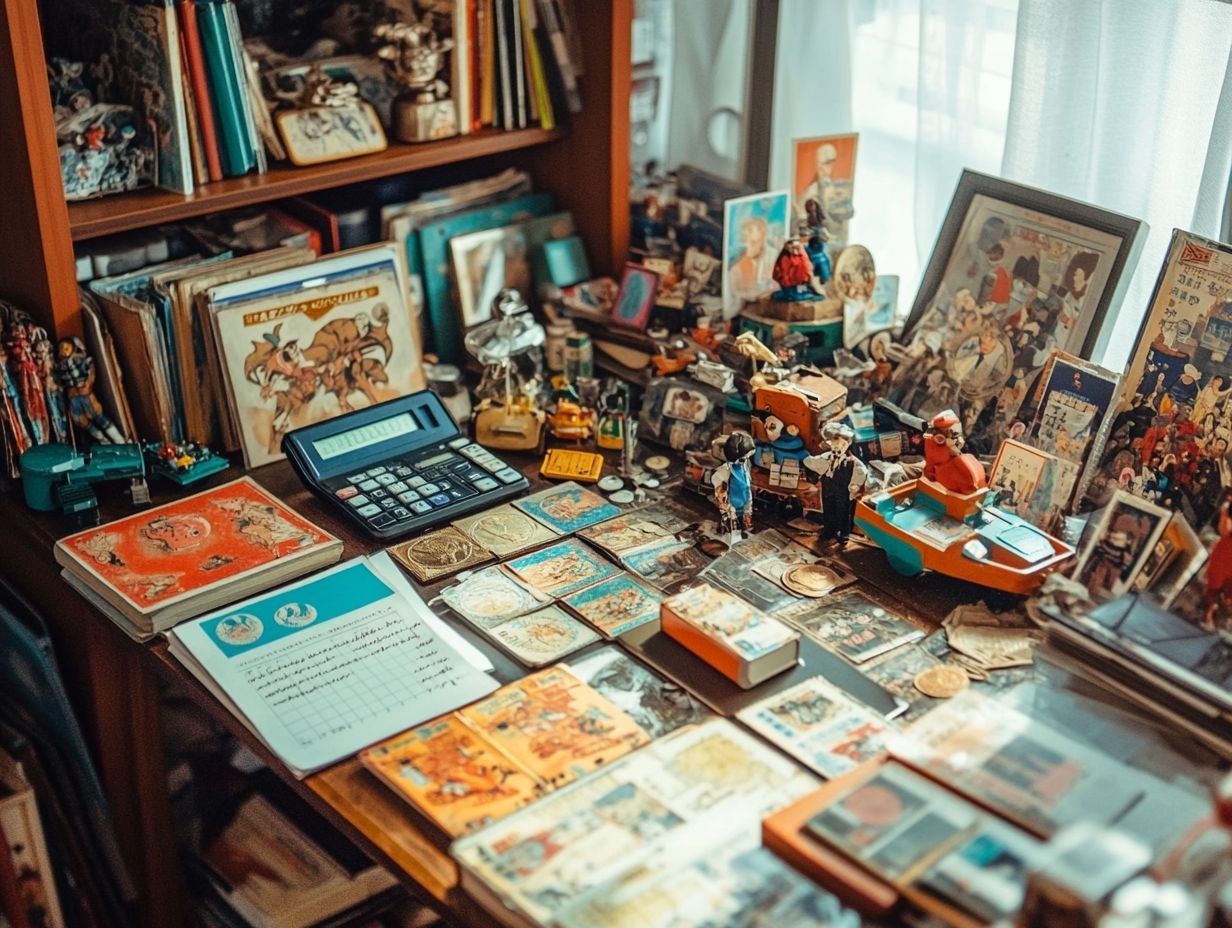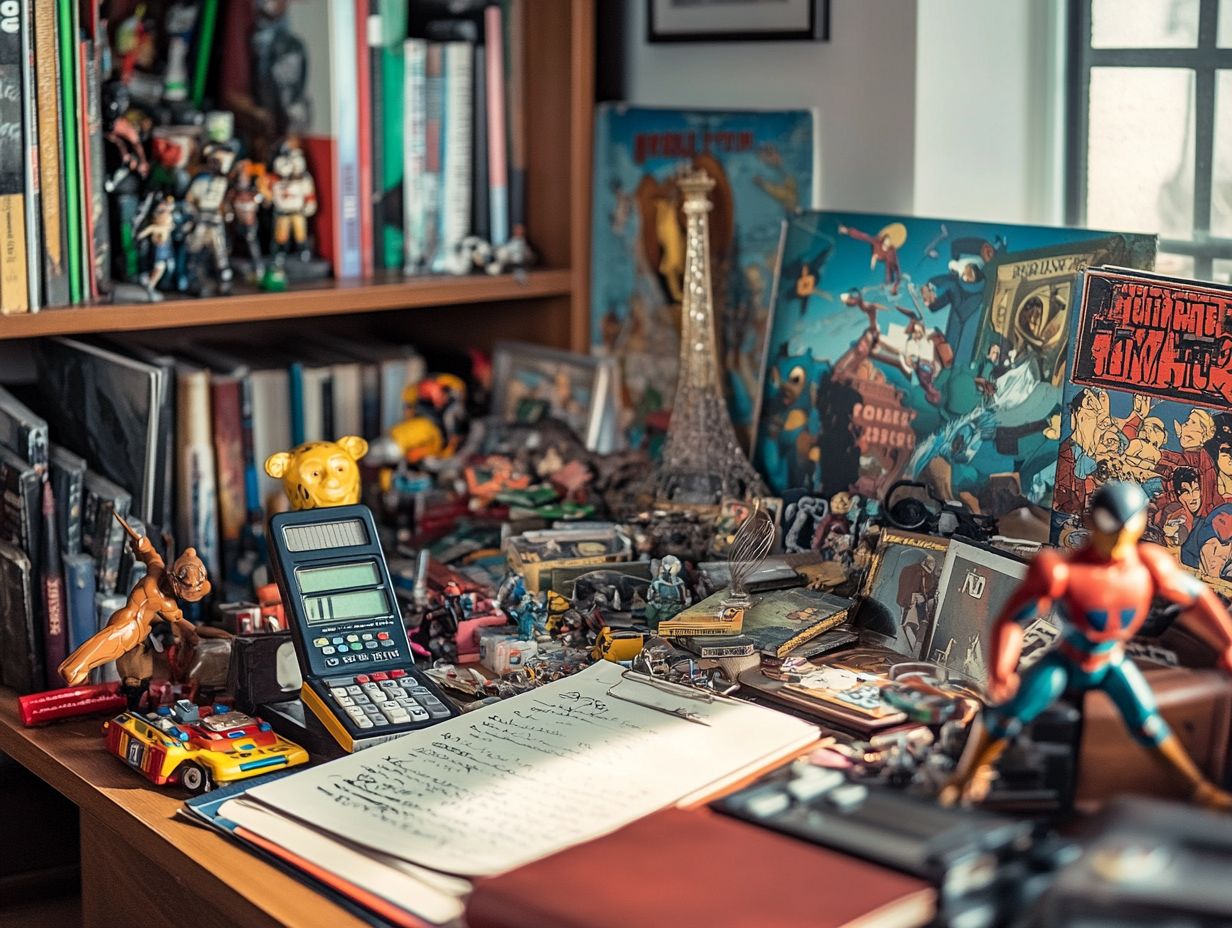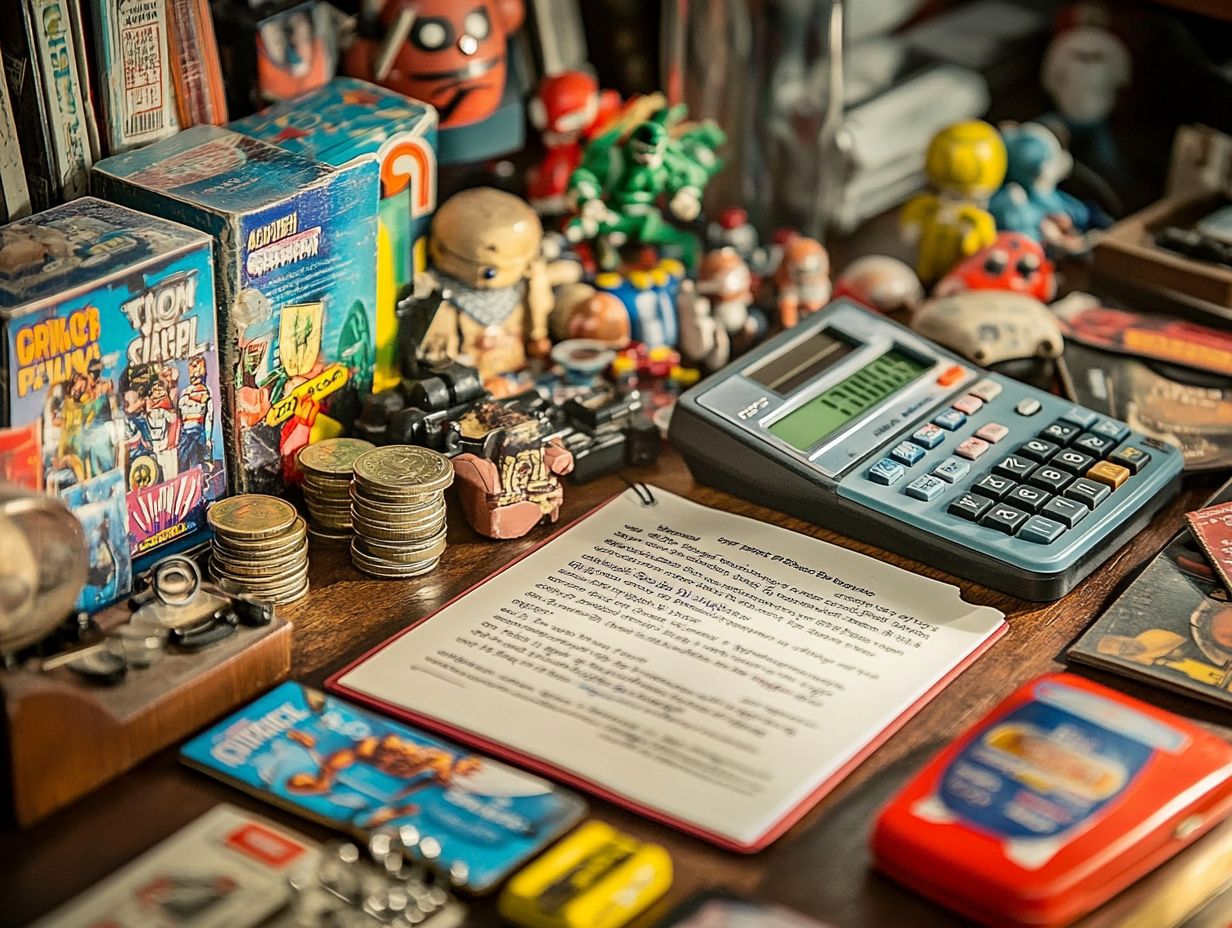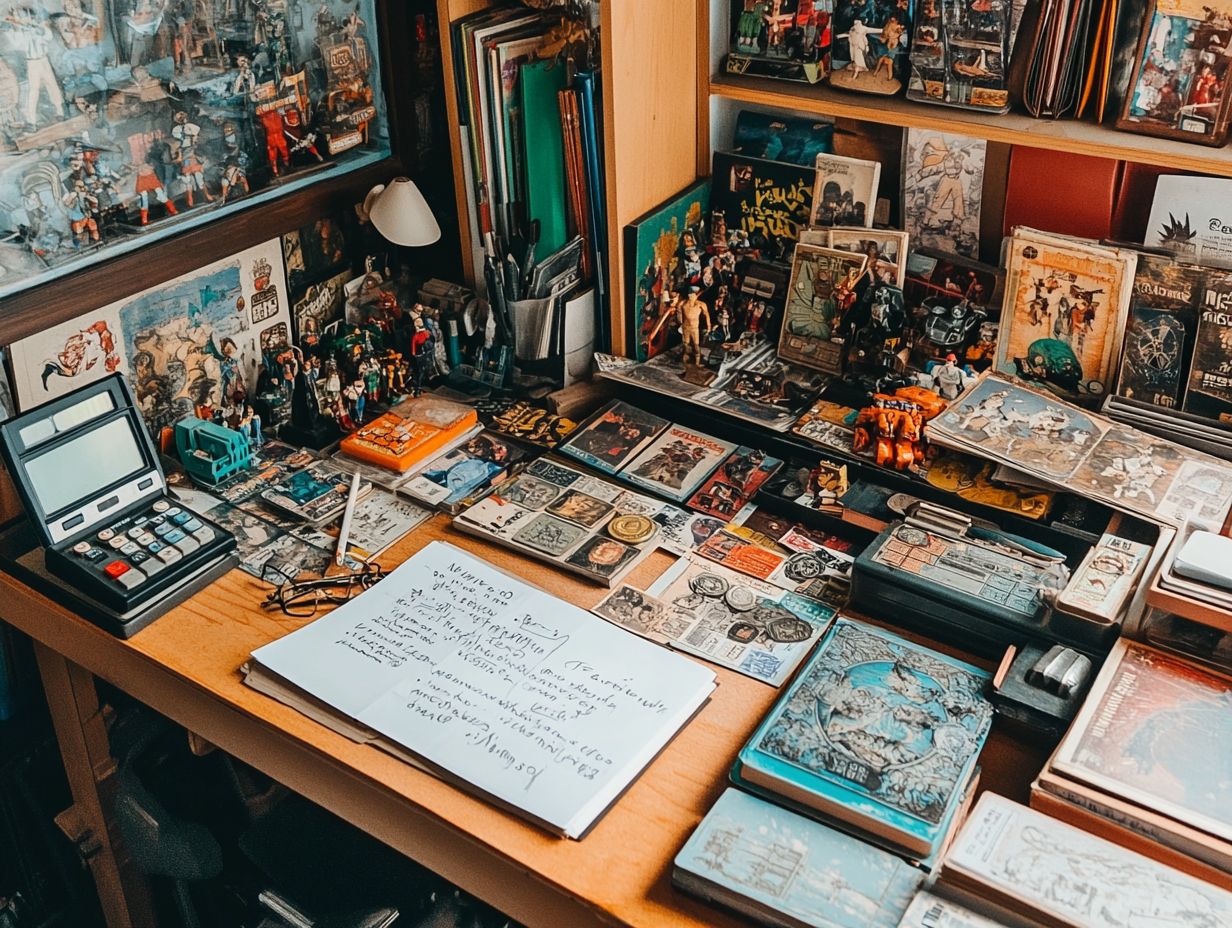What Are the Most Common Mistakes in Collectible Investing?
Dive into the thrilling world of collectible investing! While it can be an exhilarating and potentially lucrative pursuit, it s not without its challenges.
As a newcomer, you may find yourself falling into familiar traps that could lead to costly mistakes. From inadequate research to overlooking market trends, grasping these pitfalls is crucial for any aspiring collector.
This article delves into the most common errors in collectible investing, providing practical tips for success while highlighting strategies to steer clear of scams.
Armed with the right knowledge, you can confidently navigate this captivating world and make informed decisions.
Contents
- Key Takeaways:
- What is Collectible Investing?
- Common Mistakes in Collectible Investing
- Ignoring Market Trends
- Tips for Successful Collectible Investing
- Avoiding Scams in Collectible Investing
- Frequently Asked Questions
- What Are the Most Common Mistakes in Collectible Investing?
- Why is it important to do research before investing in collectibles?
- How can overvaluing items be a mistake in collectible investing?
- What are the consequences of not diversifying your collectible investments?
- Why is it important to consider potential future demand when investing in collectibles?
- How can improper storage and care affect the value of collectibles?
Key Takeaways:

Insufficient research and knowledge can lead to costly mistakes in collectible investing.
Overpaying for items can result in a loss of potential profits in the long run.
Ignoring market trends can lead to missed opportunities for growth and potential losses.
What is Collectible Investing?
Collectible investing is the art of acquiring items deemed collectibles think fine art, trading cards, vintage wines, classic motorcars, and antique furniture primarily for their potential to appreciate in value over time. This makes them a captivating alternative investment avenue.
The collectible market thrives on both intrinsic and commercial values, shaped by elements such as supply and demand and market trends.
Myriad investment opportunities emerge across different categories of collectibles.
Common Mistakes in Collectible Investing
As you delve into the world of collectibles investing, it s crucial to avoid the common pitfalls that could undermine your potential for profit and enjoyment.
Insufficient research, overpaying for items, and disregarding market performance are mistakes that many encounter. These mistakes can leave you with a lack of valuable information.
Ultimately, this can lead to undervalued assets or exorbitant fees that chip away at your investment income. Taking a more informed approach can enhance your experience and success in this intriguing arena.
Insufficient Research and Knowledge
Insufficient research and knowledge rank among the most common pitfalls in collectible investing, often leading you to acquire items without grasping their true appraisal value or the details of market dynamics.
Without solid information, you risk making poor investment choices that can ultimately diminish your returns.
Prioritize comprehensive market analysis by looking into historical price trends and scrutinizing auction results. Assess current demand within the collectibles community.
Engage with seasoned collectors, attend industry conventions, and utilize online platforms dedicated to appraisal and valuation. By adopting a proactive approach to stay updated on market fluctuations and expert opinions, you will be better equipped to make sound financial choices.
Investing time in gathering insights about reputable grading services, which assess the quality and condition of collectibles, and remaining attuned to market shifts can dramatically elevate your overall investment strategy.
Overpaying for Items
Have you ever bought a collectible driven by nostalgia? You might just be overpaying! Overpaying for items is a frequent misstep in the collectibles market, often driven by emotional attachment or a lack of insight into the item’s true commercial value.
This can significantly hinder both price appreciation and overall investment returns.
Consider collectors who find themselves shelling out hefty sums for vintage toys or comic books, motivated more by nostalgia and childhood memories than a careful assessment of current market dynamics.
The allure of owning a rare item can easily cloud judgment, resulting in inflated prices that fail to reflect the item’s actual worth.
Without a solid understanding of market trends and shifts in the popularity of certain collectibles, individuals risk acquiring pieces at peak valuations, only to watch those prices plummet.
Take high-profile examples, such as the sale of a first-edition Pok mon card or a signed sports jersey. These cases illustrate how emotional biases can drive up costs, ultimately affecting the potential for a successful investment.
Start your collectible journey today do your research and stay informed!
Ignoring Market Trends

Ignoring market trends is a critical misstep in the realm of collectible investing. Staying informed about the collectibles market such as changes in demand for items like trading cards and fine art is essential for developing a sound investment strategy.
Being attuned to these trends can dramatically influence your investment decisions. It affects not only when you should make a purchase but also which types of collectibles might appreciate over time. For example, recognizing seasonal demand spikes or shifts in collector interest can help you curate a well-rounded portfolio.
To keep your finger on the pulse, consider subscribing to industry newsletters, engaging in forums, and following reputable auction houses for invaluable insights. Additionally, platforms that aggregate sales data related to collectibles can give you the power to make informed decisions, simplifying your navigation in this changing market.
Tips for Successful Collectible Investing
To successfully navigate the realm of collectible investing, embrace proven strategies. Conduct thorough research to understand the market, set a realistic budget to guide your purchases, and diversify your collection. This approach not only minimizes risks but also enhances your potential for impressive returns on your investment.
Conducting Thorough Research
Conducting thorough research is essential in collectible investing, allowing you to grasp market dynamics how supply and demand affect prices and availability valuation methods, and the intricacies of collectibles valuation. These are key elements for making informed decisions and effectively managing risk.
This process involves leveraging a variety of resources, including market analysis reports that shed light on trends and price fluctuations. Seeking insights from seasoned collectors and appraisers can provide you with invaluable guidance on authenticity and rarity.
Use additional tools for valuation, such as online databases and auction results. By exploring these diverse resources, you can broaden your knowledge base and potentially increase your return on investment in this captivating realm.
Setting a Budget and Sticking to It
Setting a budget and adhering to it rigorously helps you stay smart and focused while investing. This practice ensures that you maintain financial discipline while exploring various collectibles, ultimately leading to a more strategic investment portfolio that performs better in the market.
By clearly defining your financial limits, you can sidestep impulsive purchases that often derail your investment goals. Establishing a budget prioritizes your investments and fosters sound decision-making amidst market fluctuations.
To manage your budget effectively, it s important to track your expenses diligently and reserve a portion for unexpected opportunities that can arise in this dynamic market. Additionally, consider allocating funds for research and education, as a well-informed approach will significantly enhance your ability to identify valuable collectibles.
Ultimately, a well-defined budget gives you the power to pursue your passion while minimizing risks, creating a harmonious balance between enjoyment and financial growth.
Diversifying Your Collection
Diversifying means including a variety of collectibles in your collection. This strategy can significantly reduce the investment risks linked to collectible investing. By exploring various markets and trends, you can enhance both the intrinsic and resale value of your items over the long term.
Incorporating a mix of pieces such as vintage toys, rare coins, and limited-edition artwork ensures that your investment isn’t solely reliant on the performance of a single sector. For example, while the market for classic comic books may have its ups and downs, maintaining a well-rounded portfolio that includes sports memorabilia or stamps can provide a buffer against those fluctuations.
This diversified strategy not only protects your investments during turbulent times but also allows you to capitalize on emerging trends and niche markets. Ultimately, this approach leads to a more robust and potentially profitable collection.
Avoiding Scams in Collectible Investing

Navigating the world of collectible investing requires a keen eye to avoid scams. Safeguarding your investments is crucial for a rewarding collecting experience.
The market can be a treacherous landscape, filled with counterfeits and deceitful sellers eager to mislead unsuspecting buyers. Your vigilance in identifying pitfalls will not only protect your assets but also enhance your journey as a collector.
Red Flags to Look Out For
When investing in collectibles, being mindful of red flags is essential. Indicators like suspiciously low prices or a lack of history of ownership can point to potential counterfeits or fraudulent schemes.
Pay close attention to vague or incomplete descriptions; these often signal that the seller may not have your best interests at heart. For instance, if you come across an artwork priced significantly lower than its market value without a valid explanation, it’s prudent to dig deeper.
Scrutinizing the seller’s reputation through reviews or their auction history can provide invaluable insight into their credibility. This approach enables you to make informed decisions, helping you sift through dubious listings that could lead to financial loss or disappointment.
Protecting Your Investments
Protecting your investments in collectibles is essential for maintaining their value over the long term. This involves using insurance, maintaining proper storage conditions, and implementing accurate valuation methods to safeguard against loss or damage.
Effective insurance coverage is crucial; it provides financial security in the event of theft or destruction and brings peace of mind for collectors who hold their items dear.
Optimal storage techniques, such as using climate-controlled environments and acid-free containers, are key to preserving the integrity of delicate pieces.
Regularly conducting valuation assessments allows you to stay informed about current market trends and the evolving worth of your collectibles. This enables you to make educated decisions about buying, selling, or further investing.
By employing these strategies, you can significantly enhance the protection and appreciation of your treasured assets.
Frequently Asked Questions
What Are the Most Common Mistakes in Collectible Investing?
The most common mistakes in collectible investing include insufficient research, overvaluing items, not diversifying your collection, neglecting potential future demand, and failing to store and care for your collectibles properly, which can lead to understanding the risks of investing in collectibles.
Why is it important to do research before investing in collectibles?

Research helps you understand the market, identify valuable items, and make informed decisions about your investments. Without it, you might overpay for items or invest in those with little growth potential.
How can overvaluing items be a mistake in collectible investing?
Overvaluing items can lead to paying too much and ultimately losing money when it’s time to sell. It’s important to accurately assess collectible values based on market trends and demand.
What are the consequences of not diversifying your collectible investments?
If you don’t diversify, you risk putting all your eggs in one basket. If a particular market or item loses value, you could face significant losses. Diversification helps mitigate risk and can lead to better overall returns.
Why is it important to consider potential future demand when investing in collectibles?
Collectibles can be trendy, and market demand can fluctuate. Considering potential future demand ensures your items will hold or increase in value over time.
How can improper storage and care affect the value of collectibles?
Wondering why storage matters? Improper care can lead to damage and decrease the value of your collectibles. Items not stored or cared for properly may be harder to sell in the future, resulting in lost potential profits.
Don’t miss the chance to protect your collectibles! Stay informed and make wise investments.






